Reflection on K-PAI’s Twelfth Forum - The Marketing Intelligence Revolution and the Perpetual Partnership in Action
posted: 10-Oct-2025 & updated: 12-Oct-2025
Share on LinkedIn | Instagram | Twitter (X) | Facebook
Want to share this reflection? Use this link — https://k-privateai.github.io/seminar-reflections/12 — to share!
The 12th K-PAI Forum demonstrated how Artificial Intelligence is fundamentally transforming digital marketing from intuitive guesswork into precision science—while simultaneously showcasing the tangible benefits of the historic KOTRA Silicon Valley partnership through exceptional hospitality and world-class content delivery.
AI generates Podcasts
Videos
Audios
Where Speed Meets Sophistication
The 12th Silicon Valley Private AI Forum (K-PAI), held on October 8, 2025, at KOTRA Silicon Valley’s Alaska venue, marked a unique moment in K-PAI’s evolution—the first forum to occur in rapid succession following the previous month's historic event. This compressed timeline, far from diminishing the forum’s impact, actually amplified the community’s energy and demonstrated K-PAI’s capacity to deliver exceptional value at an accelerated pace. The evening brought together marketing professionals, AI researchers, and adtech entrepreneurs to explore how artificial intelligence is revolutionizing digital advertising through sophisticated video analysis, mathematical budget optimization, and intelligent programmatic systems.
The forum’s theme—”Ad Intelligence - AI Revolution in Digital Marketing”—proved remarkably timely as the digital advertising industry grapples with fundamental transformations driven by privacy regulations, cookie deprecation, and the explosive capabilities of modern AI systems. The combination of Dr. Sunghyuk Park’s practical entrepreneurial insights from building ADOASIS and Diko Ko’s comprehensive engineering perspective from extensive relevant industry experience created a compelling narrative arc from specific applications to systemic architecture.

The Double-Forum Dynamic - Innovation at Velocity
The forum’s timing deserves special attention. As noted in the announcement, K-PAI’s 11th forum (Power Paradigm) concluded on September 29, and the 12th forum launched just nine days later on October 8—a scheduling compression that might concern other organizations but which K-PAI executed flawlessly! This rapid cadence emerged from practical constraints; the September Forum required month-end timing due to speaker availability across four distinguished energy experts, while the October Forum needed early-month positioning for logistical reasons.
Yet this “accidental” acceleration revealed important insights about K-PAI’s organizational maturity. The ability to deliver two world-class forums within ten days—each with multiple speakers, comprehensive technical content, premium hospitality, and extensive networking opportunities—demonstrates institutional capabilities that extend far beyond periodic event management. The KOTRA Silicon Valley Partnership proved instrumental in enabling this velocity, providing consistent venue access, exceptional catering, and operational support that allowed the organizing committee to focus on content quality rather than logistical firefighting.

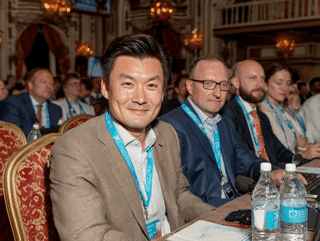
Attendee feedback reinforced that the rapid succession enhanced rather than diminished engagement. Several participants noted that the back-to-back forums created a sense of momentum and continuity, with insights from the energy-focused Power Paradigm forum informing discussions about AI marketing’s computational requirements and sustainability implications. The double-forum experience positioned K-PAI not as a quarterly gathering but as a dynamic platform capable of responding to community interests with agility.
Perhaps most remarkably, the compressed timeline not only maintained but actually amplified community engagement. The organizing committee initially harbored concerns that two consecutive forums within a nine-day window might exhaust the community, leading to diminished attendance as professionals faced calendar conflicts or event fatigue. These concerns proved entirely unfounded: the 12th forum reached maximum venue capacity with over 110 attendees—exceeding the attendance of previous standalone events held at comfortable monthly intervals. This turnout validated that K-PAI has cultivated a community sufficiently engaged and diverse that back-to-back forums appeal to overlapping but distinct audience segments, with some attendees prioritizing energy topics (the 11th forum) while others focused on marketing applications (the 12th forum), and many attending both for comprehensive AI industry insights.
The Partnership Delivers - Premium Experience as Standard
The Perpetual Partnership as a form of Strategic Alliances between K-PAI and KOTRA Silicon Valley, announced at September’s Forum, demonstrated its tangible value through this event’s exceptional execution. The premium luxury dinner experience that opened the evening—featuring carefully curated cuisine and world-class hospitality—established a welcoming atmosphere that facilitated the meaningful professional connections K-PAI forums have become known for generating.

The partnership’s value extends beyond hospitality. KOTRA SV’s commitment to providing premium venue access solved one of the most persistent challenges facing community organizations in Silicon Valley—securing professional spaces that match the caliber of the content and speakers. The Alaska venue’s elegant setting and technical capabilities enabled seamless presentation delivery while reinforcing K-PAI’s positioning as a premier forum for serious AI discourse.
Most significantly, the partnership enables sustainability and predictability in K-PAI’s operations. Rather than negotiating venue access for each event, the perpetual agreement provides a stable foundation that allows the organizing committee to focus energy on speaker recruitment, content curation, and community building. This operational efficiency directly contributed to K-PAI’s ability to execute the compressed double-forum schedule successfully.
Dr. Sunghyuk Park - The Practical Revolution in Video Advertising
Dr. Sunghyuk Park’s presentation on “The Future of Advertising Revolutionized by AI” provided a masterclass in how academic research translates into commercial impact. As CEO of Impact AI and Assistant Professor at KAIST, Park bridges the worlds of rigorous scholarship and entrepreneurial execution—a combination that produced genuinely novel insights into AI-driven advertising optimization.
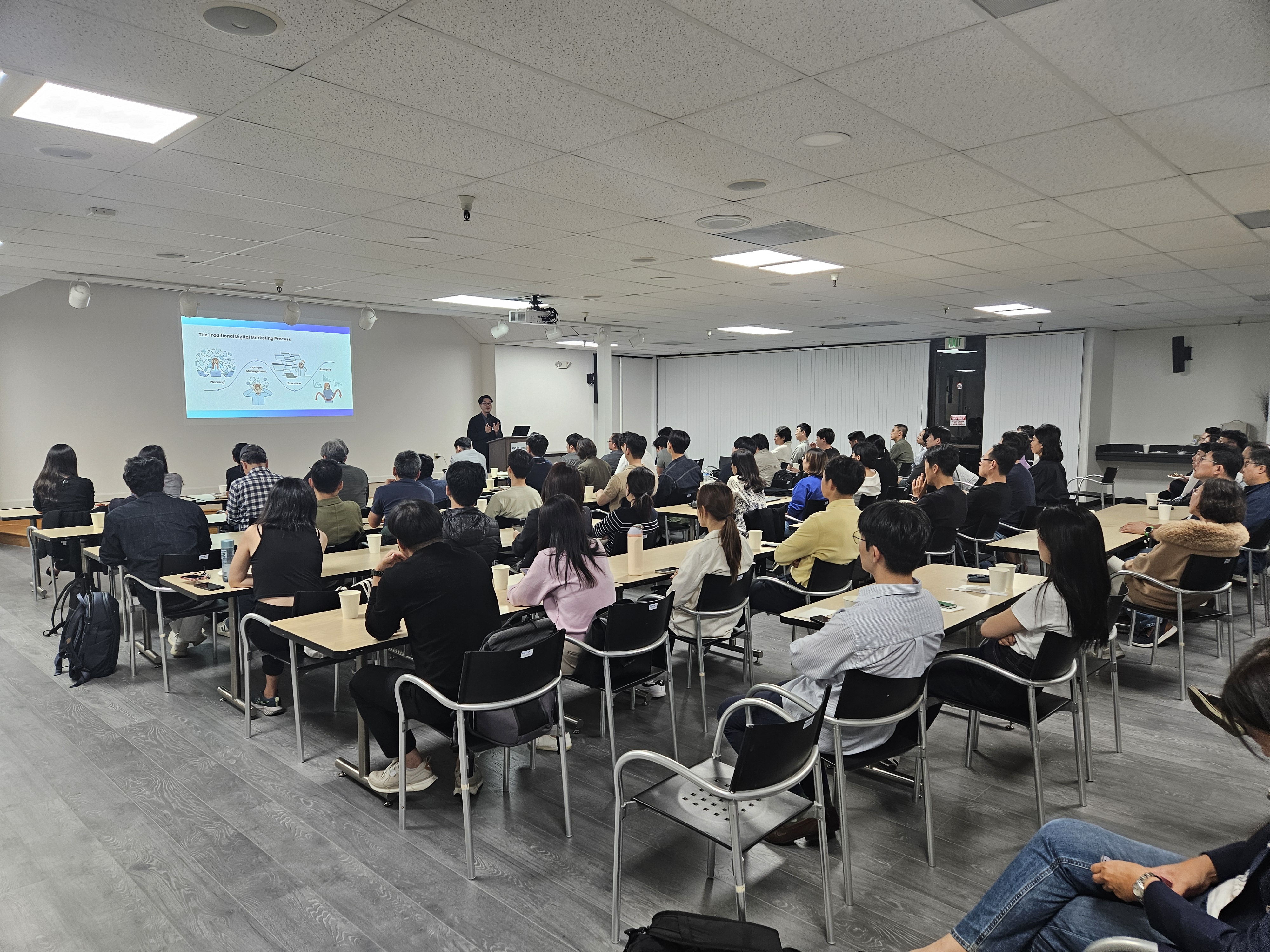
The ADOASIS Platform - Intelligence at the Video Level
Park’s central contribution lies in recognizing that video content itself represents the critical but overlooked variable in advertising effectiveness. Traditional digital advertising treats video inventory as fungible—advertisers specify demographic targets and keywords, then their ads appear on whatever videos the platform’s algorithm selects. Park’s insight: the specific videos on which ads appear dramatically affect campaign performance, yet advertisers have historically lacked tools to control this placement at granular levels.
The ADOASIS platform addresses this gap through AI-powered video analysis that enables both “on-targeting” (identifying the best 10% of videos aligned with brand values and campaign objectives) and “de-targeting” (blocking the worst 20% of inappropriate videos). This dual approach—simultaneously pursuing positive alignment and avoiding negative associations—represents a more sophisticated framework than traditional binary inclusion/exclusion targeting.
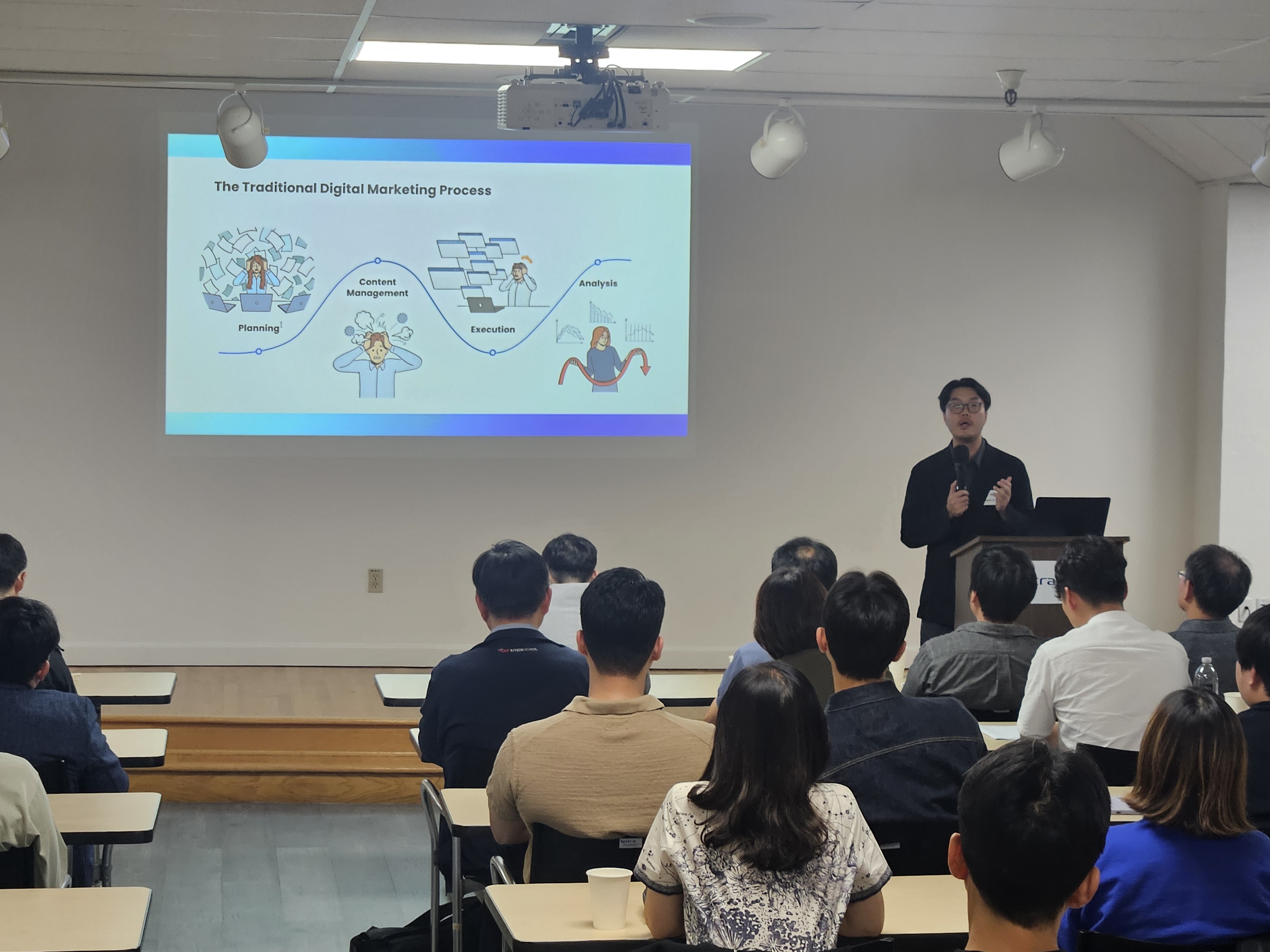
Park’s technical explanation revealed that ADOASIS analyzes video content across multiple dimensions:
Content Classification - Computer vision and natural language processing extract semantic understanding of video themes, tone, and subject matter beyond simple keyword matching.
Brand Safety Analysis - AI models detect potentially controversial, offensive, or brand-inappropriate content that might damage advertiser reputation if ads appear alongside such material.
Audience Affinity Prediction - Machine learning predicts which video content attracts audiences most likely to engage with specific advertiser messages based on behavioral patterns rather than declared demographics alone.
Contextual Relevance Scoring - Algorithms assess thematic alignment between video content and advertising creative, improving message resonance and reducing viewer ad fatigue.
The case studies Park presented demonstrated dramatic performance improvements:
Healthcare Campaign A - Implementing both on-targeting and de-targeting for a female-focused health product reduced Cost Per Click (CPC) by 23.9% without any other campaign modifications. The AI simply ensured ads appeared on more appropriate videos and avoided problematic placements.
Healthcare Campaign B - A male-targeted medical service saw even more impressive results—64.9% CPC reduction after applying ADOASIS’s video targeting methods. Park noted this larger improvement likely reflected the baseline campaign’s particularly poor video selection, demonstrating how AI can recover performance from fundamentally flawed manual targeting approaches.
Consumer Goods Campaign C - For a female-targeted consumer product, on-target reach ratio improved by 39.5%, meaning significantly more ad impressions reached the intended audience within the same budget allocation.
Marketing Mix Modeling - The Optimization Layer
Beyond video-level targeting, Park introduced ADOASIS’s approach to Marketing Mix Modeling (MMM)—the classic challenge of allocating advertising budgets across multiple channels (Google, Meta, TikTok, etc.) to maximize overall campaign performance. This represents a complex mathematical optimization problem that has traditionally relied on statistical regression models built on historical data.
Park’s innovation involves applying AI-powered optimization that continuously learns from campaign performance data to recommend budget reallocations. The system addresses the fundamental question: “Given 100,000 videos across multiple platforms with different performance characteristics, and a fixed budget, how should we allocate spend to maximize conversions, minimize cost per acquisition, or achieve other campaign objectives?”

The presentation showed how ADOASIS’s MMM achieved 25% average performance improvement across diverse campaigns by dynamically shifting budget toward higher-performing channels and video categories. Critically, these optimizations occur within existing campaign structures—advertisers don’t need to redesign creative, change targeting parameters, or modify landing pages. The AI simply directs budget more intelligently across available inventory.
Park’s discussion of the Wharton AI & Analytics Initiative and Google Research Partnership validated ADOASIS’s academic rigor. The fact that his proprietary Marketing Mix Model outperforms both Meta’s Robyn and Google’s Lightweight MMM—open-source tools from two of the world’s most sophisticated advertising platforms—in terms of both accuracy (lower error rates) and operational efficiency (faster computation, lower cost) represents a genuine technical achievement worthy of academic-industry collaboration.
The Generative AI Integration - Creative Analysis at Scale
Park’s presentation culminated with ADOASIS’s integration of Generative AI for creative performance analysis—specifically, analyzing banner images and video creatives to predict performance and optimize budget allocation at the asset level. This represents the frontier of AI advertising: moving beyond optimizing where ads appear to optimizing the creative content itself.
The case study demonstrated analyzing automotive advertising creatives across different asset types (closeup images, full vehicle images, interior shots, video content). ADOASIS’s Gen AI models predicted which creative types would perform best for specific campaign objectives, then recommended budget reallocations that achieved 21.30% lead improvement and 23.70% CPA (Cost Per Acquisition) reduction compared to the advertiser’s original creative budget allocation.
This creative-level optimization addresses one of advertising’s persistent challenges: creative fatigue and the need for constant asset refresh. By systematically analyzing which creative elements drive performance, ADOASIS enables data-driven creative strategy rather than relying on subjective creative judgment alone.
Diko Ko - The Architectural View from 30,000 Feet
If Park’s presentation zoomed into specific AI applications revolutionizing advertising practice, Diko Ko’s talk provided the essential wide-angle perspective—mapping the entire digital advertising ecosystem and identifying where AI/ML creates value across each component. As Director of Engineering at Toss USA, Ko brings deep technical expertise in building scalable advertising platforms, and his presentation revealed both the complexity and the elegant systematization that modern programmatic advertising has achieved.

The Historical Evolution - From Manual to Intelligent
Ko’s historical framing proved invaluable for understanding why AI has become essential rather than optional in digital advertising. He traced the industry’s evolution through distinct phases:
Direct Sales Era (1990s-early 2000s) - Publishers sold banner ads directly to advertisers through manual contracts and insertion orders. Limited targeting (basic contextual placement based on site theme), high barriers for small advertisers, and entirely manual workflow characterized this period. The inefficiency was staggering—sales teams negotiating individual deals, no real-time optimization, and massive unsold “remnant” inventory wasted.
Ad Networks (2000s) - The first attempt at systematization emerged when ad networks aggregated inventory from multiple publishers and sold it in bulk to advertisers and agencies. This improved efficiency compared to 1:1 direct deals but introduced black-box pricing and transparency issues. Advertisers gained some basic targeting (demographics, content categories) but lacked granular control or performance visibility.
Programmatic Era (late 2000s-present) - The introduction of Ad Exchanges, Supply-Side Platforms (SSPs), and Demand-Side Platforms (DSPs) fundamentally transformed advertising into a real-time marketplace. Ko emphasized that OpenRTB (Real-Time Bidding) standardization—created by IAB Tech Lab starting in 2011—enabled this revolution by establishing common protocols for programmatic buying and selling across all platforms.
Mediation and Header Bidding (mid-2010s-) - As the ecosystem matured, publishers gained tools to optimize yield by allowing multiple demand sources to compete for each impression. Mediation platforms (especially in mobile) and header bidding (in web) enabled true price discovery across demand sources.
Ko’s key insight: Each evolutionary phase increased complexity while demanding faster decision-making, creating inexorable pressure toward AI/ML automation. When auctions occur in <100 milliseconds and involve thousands of potential bidders evaluating millions of impressions, human decision-making becomes impossible. AI isn’t optional; it’s the only viable operating model.
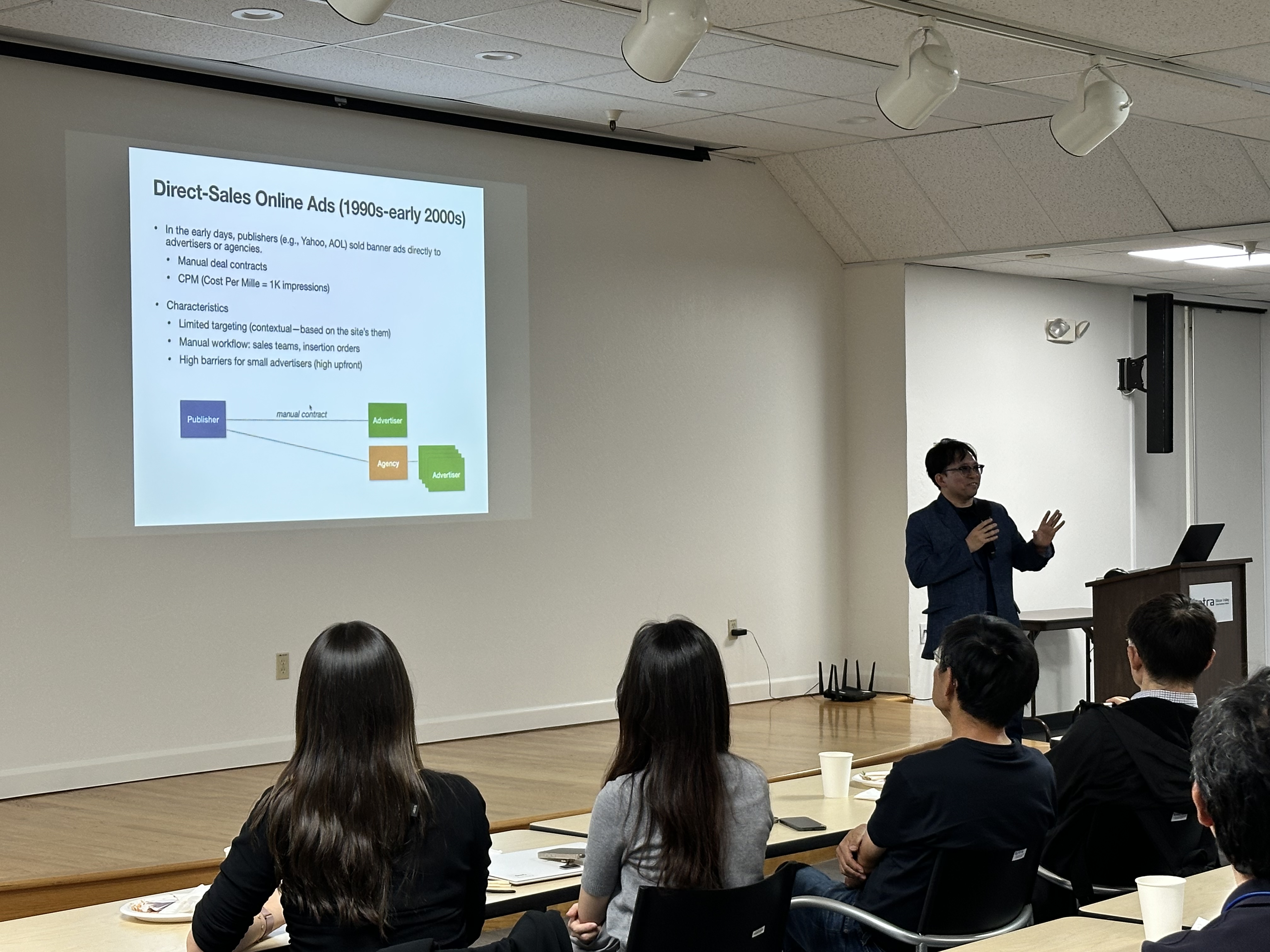
The Market Landscape - Following the Money
Ko provided essential context about digital advertising’s economic scale: ~$740 billion global market in 2025, broken into major segments:
- Retail Media / Commerce Ads: 20-25% (~$160B)
- Non-Retail Search Ads: 20-25% (~$160B)
- Display / Social / Other (CTV): 50-60% (~$420B)
This market segmentation matters because each segment employs AI differently. Search advertising (Google’s original business model) pioneered using ML for keyword relevance and quality scoring. Retail media networks (Amazon, Walmart, Target) leverage first-party purchase data for highly accurate conversion prediction. Display and social advertising rely heavily on behavioral targeting through user modeling and lookalike audience expansion.

The sheer scale—nearly three-quarters of a trillion dollars annually—explains why incremental AI improvements translate to massive value. If ADOASIS’s 25% performance improvement applied across even a fraction of this market, the economic impact would measure in tens of billions of dollars. These economics drive relentless investment in AI advertising research and platform development.
Where AI Creates Value - A Systematic Mapping
Ko’s most valuable contribution was systematically mapping AI applications across each ecosystem participant, revealing how intelligence distributes throughout the advertising value chain:
Publishers - Maximizing Yield Through Content Understanding
Content Classification (CV/NLP) - Computer vision and natural language processing detect ad-appropriate or brand-safe content, enabling publishers to label inventory accurately for targeting while protecting advertiser brand safety.
Ad Layout Optimization - Machine learning predicts best-performing placements per user/session—should ads appear above-the-fold, within content, or at page bottom? Should native ads be mixed with editorial content or clearly separated?
User Engagement Prediction - Forecasting scroll depth, dwell time, and interaction probability refines inventory value assessment. An impression where users typically engage deeply with surrounding content commands higher prices than impressions users quickly scroll past.
Fraud Detection - Anomaly detection models identify invalid traffic patterns—bot activity, click farms, domain spoofing—protecting both publisher reputation and advertiser budgets from waste.
SSPs - Optimizing the Supply Side
Bid Landscape Forecasting - Predicting expected bid ranges guides floor pricing decisions—setting minimum bids too high leaves inventory unsold, while setting them too low sacrifices revenue.
Auction Optimization - ML chooses between header bidding, direct deals, programmatic guaranteed, private auctions, or open auctions based on predicted yield for each impression.
Traffic Quality Scoring - Detecting low-quality impressions or click fraud before sending to exchanges protects SSP reputation and advertiser relationships.
Latency Prediction - Optimizing routing between exchanges and demand sources to meet <100ms Service Level Agreements requires predicting network and compute costs across complex distributed systems.
Ad Exchanges - Fair and Fast Auctions
Auction Dynamics Simulation - Predicting clearing prices under different auction types (first-price vs. second-price) enables exchange operators to design mechanisms that balance fairness, efficiency, and revenue.
Bid Shading - Estimating optimal bid adjustment strategies for DSPs participating in first-price auctions (where winners pay their bid amount rather than second-highest bid plus one cent).
Fraud/Anomaly Detection - Identifying unusual bidding patterns or replay attacks protects auction integrity.
Latency Optimization - Meeting <100ms total latency requirements across bid request distribution, bid collection, auction execution, and creative delivery demands sophisticated optimization.

DSPs - Maximizing ROI Through Intelligence
This is where Ko’s presentation dove deepest, reflecting his direct engineering experience building demand-side systems. He identified six critical AI applications:
Retrieval - Candidate ad selection using embedding similarity—given a user and context, which of millions of possible ads should we even consider showing? Ko presented Pinterest’s two-tower model architecture, where separate neural networks encode user features and ad features into shared embedding spaces. Cosine similarity in this space enables fast approximate nearest-neighbor search to identify top-K candidate ads in milliseconds.
Ranking - Once retrieval narrows millions of ads to hundreds of candidates, ranking models predict Click-Through Rate (CTR), Conversion Rate (CVR), and ultimately Return on Investment (ROI) using deep neural networks that capture complex feature interactions. Ko emphasized that modern ranking uses sophisticated DNN architectures rather than simple logistic regression.
Budget Pacing - Predictive control systems ensure campaign budgets spend evenly across time periods or aggressively when performance peaks. This prevents campaigns from exhausting budgets too quickly (missing end-of-period high-value impressions) or spending too slowly (leaving money unspent).
Bid Shading - In first-price auctions (now standard across most exchanges), predicting the minimum winning bid rather than bidding true value saves budget while maintaining win rates.
Creative Optimization - A/B testing and multi-armed bandit algorithms test headline/image variations and allocate impressions toward better-performing creative assets.
User Modeling - Sequence models (RNNs, Transformers, Graph Neural Networks) predict behavior and intent from user interaction histories, enabling more accurate targeting than simple demographic features alone.
Advertisers - Strategic Intelligence
Audience Segmentation - Clustering users by intent, demographics, and predicted Lifetime Value (LTV) enables targeted messaging and budget allocation.
Attribution Modeling - Data-driven contribution analysis determines which touchpoints in multi-channel customer journeys deserve credit for conversions.
Media Mix Modeling - Regression and causal ML allocate spend across channels—exactly the problem Park’s ADOASIS addresses with its optimized MMM approach.
Creative Generation - Large Language Models and diffusion models generate personalized copy or images, automating what was historically expensive human creative labor.
Performance Prediction - Forecasting campaign ROI and customer LTV enables proactive budget adjustments rather than reactive optimization after poor performance emerges.
Brand Lift Analysis - Statistical inference models measure awareness and recall metrics from controlled experiments, quantifying advertising’s impact beyond direct-response metrics.
The Pinterest Deep Dive - Making Retrieval Concrete
Ko’s detailed walkthrough of Pinterest’s ad retrieval architecture transformed abstract concepts into concrete engineering patterns. The system demonstrates how modern DSPs handle the fundamental challenge: given a user request, select the best ads from millions of candidates in <100 milliseconds.
Signal Enrichment - Multiple graph-based expanders fetch features from key-value stores—user demographics, historical behaviors, contextual signals—enriching the sparse initial request with hundreds of features needed for intelligent decision-making.
Two-Tower Architecture - Separate neural networks process user information and ad information, each producing dense embedding vectors in a shared latent space. This architecture enables offline pre-computation of ad embeddings—since ad characteristics change slowly compared to real-time user contexts, ads can be encoded once and stored for fast retrieval.
Approximate Nearest Neighbor Search - Rather than computing similarity between the user embedding and every ad embedding (millions of comparisons), specialized indexes (ANN indices, inverted indices) enable sub-linear search that returns top-K candidates in milliseconds.
Serving Architecture - The production system separates online components (user tower, retrieval server) from offline pipelines (ad tower, index building), enabling independent scaling and optimization of each component.
This architectural pattern—retrieval via learned embeddings and approximate nearest-neighbor search—has become standard across major advertising platforms, recommendation systems, and search engines. Ko’s explanation provided attendees with a reusable mental model applicable far beyond advertising.
No One-Size-Fits-All - The Conclusion’s Wisdom
Ko concluded with a critical insight that distinguished his presentation from simplistic “AI will solve everything” narratives: There is no boilerplate template for how ML/AI should be applied in advertising. Each participant faces different objectives, constraints, and data realities.
Publishers prioritize yield maximization while maintaining content quality and user experience. SSPs balance publisher revenue against advertiser performance. Exchanges optimize for fairness and efficiency. DSPs maximize ROI for specific advertiser objectives. Advertisers pursue diverse goals from brand awareness to direct-response conversions.
These conflicting objectives mean AI systems must be designed for specific contexts rather than deployed as generic solutions. The techniques that optimize a publisher’s yield might harm advertiser ROI. The models that maximize click-through rate might select ads that generate clicks but not conversions, wasting advertiser budgets. Success requires understanding the specific problem being solved, the available data, the computational constraints, and the broader ecosystem dynamics.
Ko’s final observation resonated throughout the networking session: “Programmatic advertising is no longer about automation—it’s about intelligent decision-making at scale.” This reframing captures the evolution from simple rule-based systems to adaptive AI that learns, predicts, and optimizes across millions of daily decisions.
Convergent Themes and Cross-Pollination
The evening’s most powerful insights emerged from recognizing connections between Park’s specific applications and Ko’s systematic architecture.
The Video Content Gap
Park’s ADOASIS platform addresses what Ko’s architecture revealed as a systematic blind spot - despite elaborate systems for user targeting, bid optimization, and budget allocation, the actual content on which ads appear has historically received minimal algorithmic attention beyond basic keyword matching and brand safety filtering.
Ko’s DSP architecture discussion focused on user modeling, creative optimization, and bidding strategies—all critical components—but largely treated inventory as fungible once basic targeting criteria were met. Park demonstrated that this assumption leaves massive performance gains unrealized. The 23.9% to 64.9% CPC improvements from better video targeting aren’t marginal refinements; they represent a fundamental capability gap in current programmatic systems.
This suggests an architectural evolution opportunity - integrating video intelligence systems like ADOASIS directly into DSP retrieval and ranking stages rather than treating content analysis as a post-auction filtering step. Future DSP architectures might include a “content tower” alongside user and ad towers in multi-tower retrieval models, enabling content-aware targeting as a first-class optimization dimension.
The Measurement and Attribution Challenge
Both presentations grappled with advertising’s fundamental attribution problem, though from different angles. Ko discussed attribution modeling as a critical advertiser-side AI application—determining which touchpoints in multi-channel customer journeys deserve credit for conversions. Park’s MMM addresses the related but distinct challenge of channel-level budget allocation across platforms.
The tension: individual platforms (Google, Meta, TikTok) each claim credit for conversions using last-touch or probabilistic attribution models, often resulting in total attributed conversions exceeding actual conversions (the classic “attribution inflation” problem). Park’s MMM approach sidesteps granular attribution by using aggregate statistical relationships between spend and outcomes, but sacrifices the tactical precision that attribution modeling theoretically provides.
During Q&A, attendees explored whether combining these approaches—using MMM for strategic budget allocation while employing attribution modeling for tactical creative and audience optimization—might offer superior results. The consensus: current fragmentation across walled gardens (limited cross-platform data sharing) prevents this integration, but privacy-preserving techniques like differential privacy or federated learning might eventually enable it.
The Privacy Paradox
An undercurrent throughout both presentations involved advertising’s collision with privacy regulations and platform changes. Ko’s historical narrative showed how advertising evolved by exploiting increasingly granular user data—cookies, device IDs, behavioral tracking across sites and apps. Yet he acknowledged that this foundation is crumbling: cookie deprecation, App Tracking Transparency (ATT), GDPR, CCPA, and other privacy initiatives are eliminating the precise user identifiers that powered targeting.
Park’s content-focused approach offers a partial solution: if video content analysis can identify high-performing placement opportunities, advertisers become less dependent on granular user tracking. Contextual targeting (showing ads based on content being consumed rather than user tracking) represents a privacy-friendly alternative that ADOASIS-style video intelligence makes more sophisticated and effective.
Several attendees noted the irony: advertising is simultaneously becoming more privacy-protective (less individual user tracking) and more AI-driven (more sophisticated algorithmic optimization). The shift from “track this specific user across sites” to “predict which content contexts attract users likely to convert” represents a fundamental architectural change—from deterministic identity graphs to probabilistic behavior modeling.
The Real-Time Constraint as AI Driver
Ko’s emphasis on <100ms latency requirements illustrated how time constraints force architectural choices. When every millisecond matters, you cannot run complex models on every impression. This explains the universal adoption of two-stage architectures: fast retrieval narrows millions of candidates to hundreds using lightweight models, then more sophisticated ranking models evaluate only the retrieved candidates.
Park’s optimization systems operate on different time scales—analyzing thousands of videos offline, computing budget allocations hourly or daily—but still face computational constraints. Training MMM models on weeks of campaign data requires different techniques than real-time bid prediction.
The lesson: AI in advertising must be time-aware, with different models and techniques appropriate for different decision horizons. Real-time bidding demands low-latency inference. Budget pacing operates on hourly cycles. Creative testing runs over days or weeks. Campaign planning occurs monthly or quarterly. Effective AI advertising platforms employ a temporal hierarchy of models matched to decision timescales.
The Democratization Question
An intriguing discussion during networking explored whether AI tools like ADOASIS and sophisticated DSP platforms democratize advertising access or concentrate power among those with AI expertise and computational resources.
Optimistic view: Platforms like ADOASIS enable smaller advertisers to achieve performance previously available only to enterprises with dedicated data science teams. Park’s 25% average improvement comes from smarter algorithms, not bigger budgets. This levels the competitive playing field.
Skeptical view: Building, training, and operating AI advertising systems requires significant technical sophistication and computational infrastructure. The winners will be large platforms (Google, Meta, Amazon) and well-funded startups with ML expertise. Small businesses using these tools may see improvements but remain dependent on platform providers who control the underlying algorithms.
The reality likely combines both dynamics: AI makes certain capabilities accessible while raising the ceiling on what’s possible. A local business can now run sophisticated video-targeted campaigns through ADOASIS that would have been impossible five years ago. Meanwhile, enterprise advertisers employ teams of data scientists building proprietary models that extract even greater performance. The gap between best-in-class and average may widen even as the average improves.
Industry Implications and Emerging Patterns
The Consolidation Toward Integrated Platforms
Ko’s ecosystem map showed numerous specialized players—SSPs, DSPs, exchanges, mediation platforms, attribution providers. Yet market dynamics favor vertical integration. Google operates Ad Manager (SSP), Google Ads (DSP), AdX (exchange), and Analytics (measurement). Amazon runs a retail media network that collapses the entire stack. Meta controls inventory, demand, and measurement within its walled garden.
Park’s ADOASIS represents a different integration model: specialized intelligence as a service that sits atop existing platforms rather than replacing them. Advertisers continue buying through Google/Meta/TikTok but layer on ADOASIS’s video intelligence and MMM optimization. This “middleware” approach may offer more sustainable competitive positioning than attempting to build yet another full-stack advertising platform.
The pattern emerging: markets will support both vertically integrated platforms (Google, Amazon, Meta) and specialized intelligence layers (ADOASIS, The Trade Desk, LiveRamp) that enhance but don’t replace existing infrastructure. The key differentiator is whether a solution requires exclusive inventory access or can operate across multiple platforms.
The Shift Toward Outcome Optimization
Traditional advertising metrics—impressions, clicks, click-through rates—increasingly give way to outcome-based optimization - conversions, revenue, lifetime value, return on ad spend (ROAS). This shift reflects AI’s maturation: early systems optimized proxies (clicks) because conversion data was sparse and delayed. Modern systems handle sparse delayed signals through sophisticated modeling.
Park’s case studies demonstrated CPC reduction and conversion lift—outcome metrics that directly affect advertiser economics. Ko’s discussion of CVR and ROI prediction in ranking models reflects the same evolution. The industry consensus: optimizing for business outcomes rather than engagement metrics represents AI advertising’s future.

This has profound implications for creative strategy. If systems optimize for conversions, creatives that generate clicks but not conversions get deprioritized. Clickbait tactics that worked when CTR was the primary metric become counterproductive. Advertisers must align creative messaging with actual conversion pathways rather than attention-grabbing but misleading hooks.
The Content Quality Renaissance
An unexpected theme emerged from Park’s presentation: AI-driven advertising may actually improve content quality by better matching ads to appropriate content contexts. When advertisers can precisely target thematically relevant videos and avoid brand-unsafe content, they pay premiums for high-quality placements while deprioritizing low-quality inventory.
This creates economic incentives for publishers to produce quality content: better content attracts higher advertising rates through intelligent targeting systems. Conversely, low-quality or controversial content gets systematically de-targeted, reducing revenue. These market forces could drive a quality equilibrium where content creators invest in valuable programming to attract advertising premiums.
The counterargument: automated systems might over-optimize for “safe” content, suppressing legitimate but controversial journalism or creative expression. Brand safety filters could inadvertently censor important but difficult topics. The challenge is balancing advertiser brand protection against content diversity and editorial freedom.
The Skills Gap and Education Challenge
Both presentations assumed significant technical sophistication: embedding spaces, neural architectures, auction mechanisms, causal inference. Yet the advertising industry historically developed around creative, media planning, and account management skills rather than engineering and data science.
This creates a widening skills gap between what modern AI advertising demands and what the existing workforce provides. Marketing professionals need at least conceptual understanding of how AI systems work to use them effectively, avoid pitfalls, and interpret results. Engineering teams need domain knowledge of advertising dynamics to build useful systems.
Several attendees mentioned their organizations’ investments in cross-functional training: sending marketers to ML bootcamps, having engineers shadow media buyers, creating hybrid “marketing technologist” roles. The pattern suggests that successful advertising organizations will increasingly resemble technology companies with engineering, data science, and traditional marketing functions deeply integrated.
The Regulatory Horizon
While not a primary focus of either presentation, regulatory considerations hovered throughout discussions. The European Union’s Digital Services Act, various U.S. state privacy laws, and potential federal legislation will shape what data can be collected, how algorithms can target users, and what transparency advertisers and platforms must provide.
Park’s content-focused approach appears relatively regulation-resistant: analyzing publicly available video content raises fewer privacy concerns than tracking individual users. Ko’s discussion of identity resolution and cross-device tracking operates in legally murkier territory, particularly as regulations tighten.
Forward-thinking participants noted that AI systems designed with privacy-by-default architectures—federated learning, differential privacy, on-device computation—may gain competitive advantages as regulations evolve. Platforms that depend on extensive user tracking face greater regulatory risk than those employing privacy-preserving techniques.
Key Takeaways for Marketing and AI Practitioners
Content Is the Overlooked Dimension
The most actionable insight: video and content analysis represents advertising’s current frontier. While enormous engineering resources have optimized user targeting, bidding, and budget allocation, the specific content on which ads appear has received insufficient algorithmic attention. Organizations that integrate content intelligence into their advertising strategies will likely see performance improvements comparable to those Park demonstrated.
Implementation pathway: Audit current campaigns to understand video placement patterns. Use tools like ADOASIS or build internal content analysis capabilities. Establish brand safety and content suitability guidelines beyond basic keyword blocking. Measure performance lift from content-aware targeting to build ROI case for investment.
Architecture Matters as Much as Algorithms
Ko’s systematic mapping revealed that choosing where to apply AI is as important as which algorithms to use. Organizations should map their specific advertising challenges to the ecosystem components Ko identified, then prioritize AI investments where marginal improvements deliver disproportionate value.
For advertisers: Focus on attribution modeling, audience segmentation, and creative optimization where you control data and decisions. For publishers: Invest in content classification, engagement prediction, and fraud detection where you own inventory. For platforms: Build differentiation through unique data advantages or specialized capabilities rather than generic ML.
The Measurement Foundation Enables Everything
Both presentations implicitly assumed robust measurement infrastructure: impression logging, conversion tracking, attribution systems, experimentation frameworks. Without accurate measurement, AI optimization becomes “garbage in, garbage out.” Organizations must invest in measurement foundations before pursuing sophisticated AI.
Critical capabilities: Unified event logging capturing impressions, clicks, conversions. Integration between advertising platforms and business systems (CRM, e-commerce, billing). Experimentation infrastructure enabling A/B tests and causal inference. Data pipelines moving advertising data to analysis environments. These unglamorous infrastructure investments enable the sophisticated AI applications both speakers described.
Specialization Beats Generalization in Tools
Park’s success with ADOASIS demonstrates that specialized tools solving specific problems can compete with generalist platforms. While Google and Meta offer comprehensive advertising solutions, ADOASIS’s focused video intelligence and MMM optimization deliver superior results in their specific domain.
For entrepreneurs: Look for narrow but valuable problems within the advertising ecosystem where specialized expertise creates sustainable advantages. For practitioners: Assemble best-of-breed specialized tools rather than assuming integrated platforms provide optimal solutions everywhere. For platforms: Expect specialized competitors to chip away at specific capabilities rather than attempting wholesale platform replacement.
Privacy-Preserving Techniques Are Competitive Advantages
The industry’s shift away from granular user tracking creates opportunities for privacy-respecting approaches that deliver comparable or better performance. Content-based targeting, cohort modeling, and on-device computation may provide competitive differentiation as privacy regulations tighten and consumer preferences shift toward privacy protection.
Organizations that build expertise in privacy-preserving techniques now—differential privacy, federated learning, contextual targeting, statistical modeling on aggregated data—position themselves advantageously for the emerging regulatory and platform landscape where traditional tracking mechanisms become unavailable.
Areas for Future K-PAI Exploration
While this forum provided comprehensive coverage of AI in digital advertising, several adjacent topics warrant dedicated exploration:
Generative AI for Creative Production
Park touched on using GenAI for creative analysis, but the broader question of AI-generated advertising creative—copy, images, video—deserves deeper examination. How do human creative professionals and AI creative generation systems optimally collaborate? What quality control and brand safety considerations apply? How do we evaluate creative effectiveness when production costs approach zero?
Cross-Platform Attribution and Measurement
The measurement and attribution challenge emerged repeatedly but wasn’t fully resolved. A future forum exploring privacy-preserving cross-platform measurement—federated learning for attribution, differential privacy for aggregate reporting, statistical techniques for inferring cross-platform effects—would provide valuable insights as cookie-based tracking disappears.
The Economics of Attention and Creator Compensation
Ko’s presentation mapped money flows between advertisers and publishers, but didn’t explore creator economics in depth. How should value be distributed between platforms, content creators, and technology providers? How do AI recommendation and advertising systems affect creator incentives and content production? These questions become increasingly important as creator economies grow.
Adversarial Dynamics and Gaming Prevention
Sophisticated AI optimization creates incentives for sophisticated gaming—advertisers finding loopholes in platform rules, publishers fabricating engagement signals, fraudsters mimicking legitimate traffic patterns. The adversarial dynamics between optimization systems and those attempting to exploit them deserves examination, particularly as AI enables both more sophisticated optimization and more sophisticated fraud.
The Global Advertising Landscape
Both presentations focused implicitly on U.S. and developed market advertising. Yet emerging markets—India, Southeast Asia, Africa, Latin America—develop advertising ecosystems with different characteristics, regulations, and cultural norms. How do AI advertising systems adapt to diverse global contexts? What lessons from developed markets apply versus require fundamental rethinking?
Looking Forward - The Silicon Foundation and Strategic Korea-US Alliance
The 12th K-PAI Forum’s success in delivering exceptional content and networking despite compressed timing reinforces the value of the KOTRA Silicon Valley partnership and K-PAI’s organizational maturation. Yet the November 12th forum on “The AI Silicon Race: Korea-US Innovation Leadership” at the Korea AI & IC Innovation Center (K•ASIC) represents far more than the next event in K-PAI’s calendar—it addresses a fundamental gap in how the AI ecosystem is typically understood and discussed.
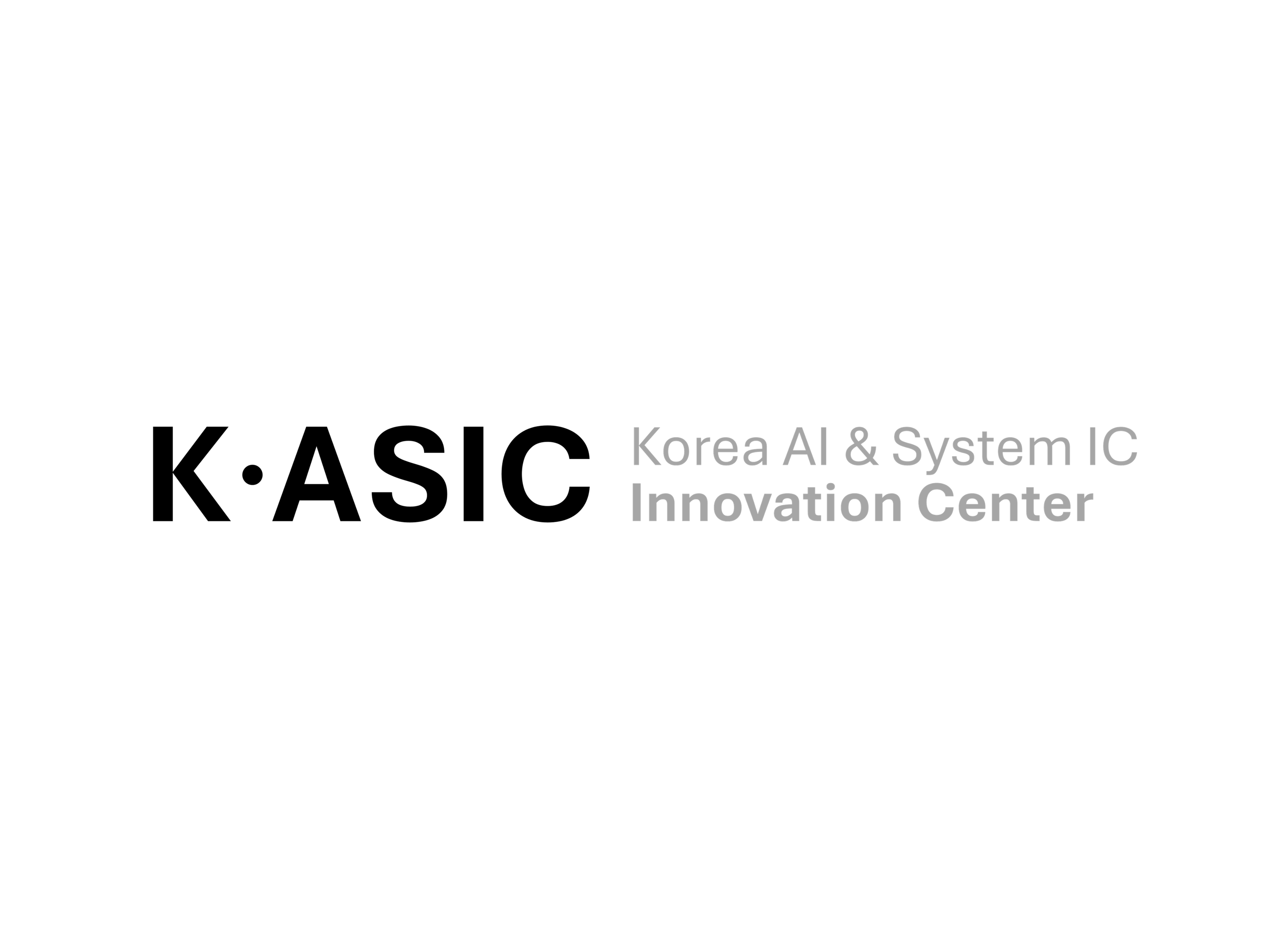

Beyond Software - The Foundational Layer
General discourse on AI tends to concentrate on highly visible layers - software services (e.g., ChatGPT, Claude, Grok, DeepSeek, Gemini, Mistral AI, etc.), algorithms (e.g., GPT-4o, diffusion models, Transformer architecture, etc.), software toolchains (e.g., MCP, LangChain, etc.), and application domains (e.g., biotech, robotics, physical AI, mobility, industrial AI, etc.). These are undeniably important, but they represent only the upper strata of a much deeper technological stack.
The term “Artificial Intelligence” itself demands interdisciplinary understanding that transcends pure technology—encompassing ethics, cognitive science, legal frameworks, and philosophical implications. AI was never the exclusive province of technologists, nor could it be, hence, most importantly, nor should it be! Even restricting our view to the technical domain, semiconductor and hardware infrastructure constitute the foundational layer upon which all AI capabilities ultimately rest.
The AI hardware ecosystem’s critical components include:
GPUs (Graphics Processing Units) - Nvidia-led parallel processing accelerators that have become synonymous with AI training and inference, though increasingly facing competition from specialized alternatives.
HBM (High Bandwidth Memory) - The next-generation memory architecture that has propelled SK hynix to prominence—exemplified by the company’s unprecedented 2,000% performance bonuses reflecting HBM’s criticality to AI systems. This technology addresses the memory bandwidth bottleneck that increasingly limits AI performance as models scale.
AI-dedicated Semiconductors - NPUs (Neural Processing Units), DPUs (Data Processing Units), and other specialized chips that offer greater efficiency than general-purpose GPUs for specific AI workloads.
Custom AI Accelerators - Domain-specific architectures designed by Microsoft, OpenAI, Google, Amazon, Apple, and Meta to optimize for their particular AI applications and escape dependence on commodity GPU markets.
A crucial observation - most of these companies function as fabless design houses, creating chip architectures but outsourcing actual fabrication to specialized foundries like TSMC. This separation between design and manufacturing creates complex dependencies and strategic vulnerabilities that became painfully apparent during recent supply chain disruptions.
The Geopolitical Semiconductor Landscape
The semiconductor industry exists inseparably from geopolitical competition, particularly the US-China technological rivalry. The CHIPS Act, export controls on advanced manufacturing equipment and chip designs, and ongoing supply chain restructuring fundamentally reshape the industry’s geography and competitive dynamics.
Korea occupies a unique strategic position in this landscape: Samsung and SK hynix lead in memory technologies essential for AI, while TSMC’s Taiwan location creates dependencies that both the US and China seek to mitigate through domestic manufacturing investments. The semiconductor supply chain’s fragmentation across Korea, Taiwan, the United States, Japan, and the Netherlands creates both resilience through diversification and vulnerability through coordination requirements.
Understanding AI’s sustainable development therefore requires deep comprehension of semiconductor ecosystems, manufacturing capabilities, supply chain dynamics, and geopolitical constraints. Software innovations mean little if constrained by silicon shortages or access restrictions.
The K-ASIC Partnership - Strategic Significance
Against this backdrop, the K-PAI and K•ASIC strategic partnership transcends simple technical exchange. The November forum will illuminate the foundational silicon and semiconductor architecture layer while functioning as a strategic platform connecting Korea-US AI semiconductor innovation leadership.
This collaboration addresses the reality that AI’s future is built on silicon, not just algorithms. The most sophisticated language models, computer vision systems, and robotics platforms remain theoretical without the computational substrate to execute them. As Park and Ko’s presentations demonstrated, even software-layer optimizations—video targeting algorithms, programmatic bidding systems—ultimately depend on sufficient computational capacity delivered economically and sustainably.
The Korea-US semiconductor alliance brings complementary strengths:
Korea’s Manufacturing Excellence - Samsung and SK hynix’s leadership in memory technologies, advanced packaging, and high-volume manufacturing provides the production capacity that AI scaling demands.
US Design Innovation - American companies’ dominance in chip architecture design, EDA (Electronic Design Automation) tools, and systems integration creates the intellectual foundation for next-generation AI accelerators.
Shared Strategic Interests - Both nations face similar challenges from China’s semiconductor ambitions and share interests in maintaining technological leadership, supply chain security, and access to critical manufacturing capabilities.
Thematic Progression and Cumulative Knowledge
The progression from October’s marketing-focused discussion to November’s semiconductor exploration demonstrates K-PAI’s evolving sophistication in creating narrative arcs across forums rather than treating each event in isolation.
The 12th forum examined how AI transforms advertising through intelligent optimization—video analysis, budget allocation, programmatic systems. These capabilities rest on assumptions about available computational resources. Park’s ADOASIS platform analyzes thousands of videos using computer vision and NLP models. Ko’s DSP architectures employ deep neural networks for retrieval and ranking. Both applications demand massive parallelizable computation that only modern AI accelerators enable.
The 13th forum will explore the silicon layer making these applications possible - How are AI chips designed? What manufacturing processes enable current and future capabilities? Where do supply chain vulnerabilities threaten AI scaling? How do Korea and the United States collaborate to maintain semiconductor leadership?
This layered approach—applications in October, enabling hardware in November—creates cumulative understanding of the complete AI stack. Attendees gain appreciation not just for what AI can do (video targeting, programmatic optimization) but for what makes it possible (specialized silicon, advanced memory, efficient manufacturing).
Future forums might continue this progression - data center architecture and energy infrastructure (building on the September Power Paradigm insights), AI security at the hardware level (extending July’s Fortress Code discussion to silicon-layer vulnerabilities), or edge AI and embedded systems (connecting semiconductor capabilities with robotics and physical AI applications).
The Expanding Partnership Ecosystem
The K•ASIC partnership complements rather than competes with the KOTRA Silicon Valley relationship. Where KOTRA provides consistent venue access, premium hospitality, and operational support enabling rapid event execution, K•ASIC brings deep semiconductor industry connections, technical expertise in chip architecture and manufacturing, and access to Korea’s leading semiconductor companies and research institutions.
This growing web of strategic partnerships positions K-PAI for sustainable long-term growth while maintaining the community’s distinctive character: rigorous technical content, cross-disciplinary dialogue, and genuine networking rather than superficial mingling. The partnerships provide:
Institutional Stability - Perpetual agreements eliminate the uncertainty of event-by-event venue negotiations and sponsorship solicitation.
Content Access - Partner networks facilitate speaker recruitment from leading companies, universities, and research institutions that might not respond to cold outreach.
International Reach - Connections spanning Korea and Silicon Valley enable truly global perspectives on AI development, regulatory approaches, and market dynamics.
Resource Efficiency - Operational support from partners allows the K-PAI organizing committee to focus on strategic vision and content quality rather than logistical details.
The November forum will demonstrate this partnership model’s full potential - co-hosted by K-PAI and K•ASIC, featuring speakers from Korean semiconductor leaders and Silicon Valley AI companies, exploring topics that bridge manufacturing expertise and application innovation, and creating connections that span the Pacific to strengthen the Korea-US AI semiconductor alliance.
The Broadening AI Discourse
The semiconductor focus also advances K-PAI’s implicit mission to broaden AI discourse beyond narrow technical optimization toward comprehensive ecosystem understanding. Just as the August Forum explored legal frameworks and humanistic principles alongside technical implementation, the November event will examine geopolitical, economic, and strategic dimensions alongside semiconductor architectures.
This multi-perspectival approach reflects the reality that AI development cannot be divorced from its context:
Technical constraints (what’s physically possible with current silicon) shape application possibilities (what AI systems can practically accomplish).
Economic forces (semiconductor manufacturing costs, supply chain economics) influence business models (which AI applications become commercially viable).
Geopolitical dynamics (export controls, manufacturing locations) affect strategic choices (which technologies to pursue, which partnerships to form).
Regulatory frameworks (chip export restrictions, technology transfer rules) constrain innovation pathways (which research directions remain accessible).
Understanding AI requires navigating these intersecting dimensions simultaneously rather than treating technology as isolated from economics, politics, and strategy. K-PAI’s evolution toward facilitating these complex discussions represents a maturation from technical education toward strategic discourse.
Conclusion
The 12th K-PAI Forum successfully demonstrated that AI’s transformation of digital advertising operates at every level—from individual video placements to system-wide architectural patterns, from real-time auction dynamics to strategic budget allocation, from creative asset generation to privacy-preserving measurement.
Park’s practical entrepreneurial insights showed how focused AI applications (video targeting, MMM optimization) deliver measurable performance improvements that directly affect advertiser economics. His willingness to share specific case studies with quantitative results—23.9% to 64.9% CPC reductions, 25% average MMM improvements—provided attendees with concrete expectations rather than abstract possibilities.
Ko’s comprehensive architectural mapping revealed how intelligence distributes throughout the advertising ecosystem, with different participants employing AI for complementary objectives. His historical narrative contextualized current AI applications within advertising’s decades-long evolution toward programmatic automation, showing how each technological generation created both new capabilities and new challenges requiring further innovation.
The convergence between these perspectives—specific applications and systemic architecture, entrepreneurial execution and engineering discipline, optimization techniques and operational constraints—created a rich tapestry of insights that attendees can apply across their diverse roles in marketing, technology, and business strategy.
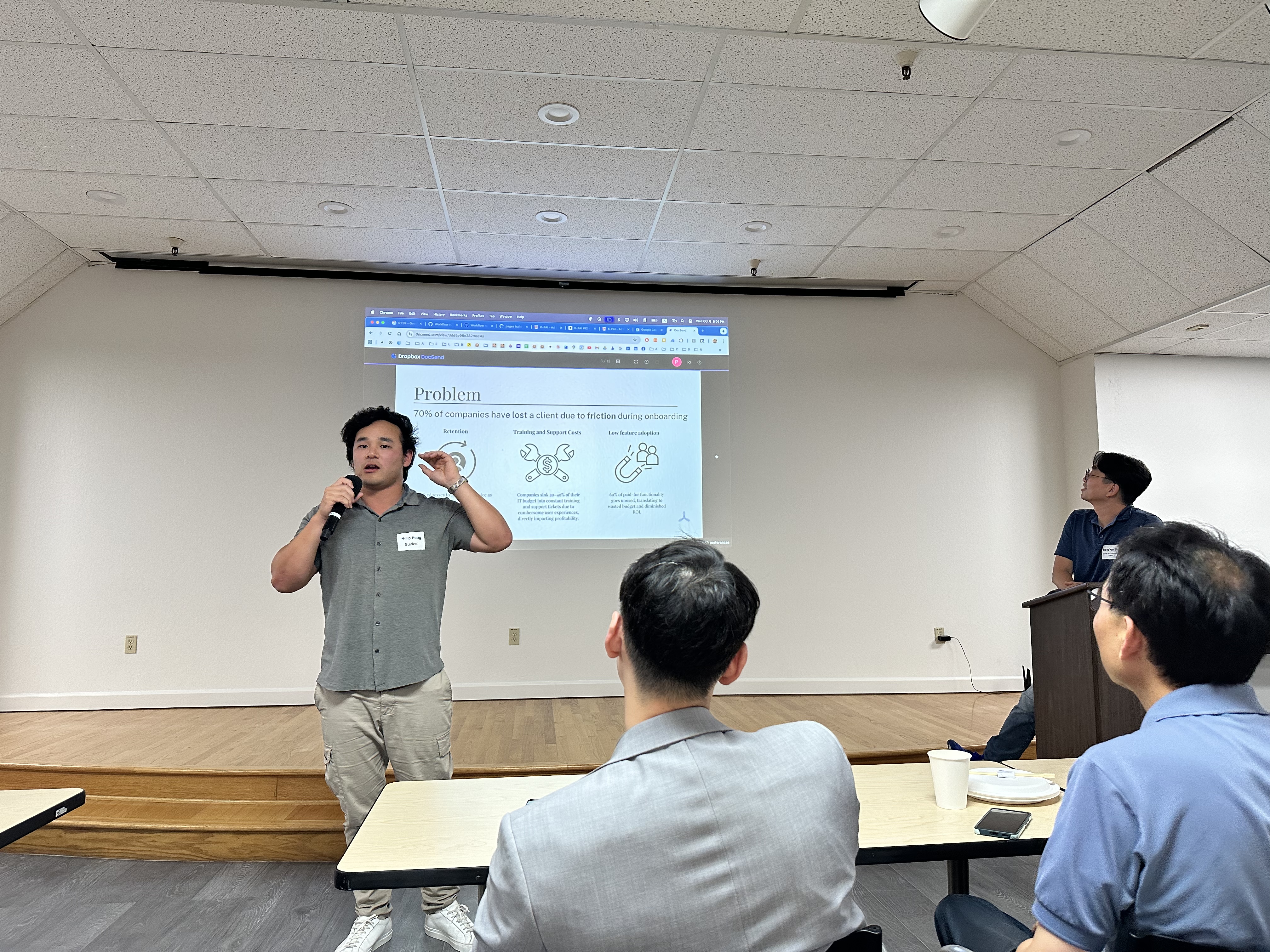
The forum also reinforced K-PAI’s community-building ethos through the member introduction session, where K-PAI members had the opportunity to introduce themselves and their work to the full assembly. This practice—now becoming a cherished tradition at K-PAI forums—transforms attendees from passive audience members into active community participants. Hearing fellow members describe their companies, research, and professional interests created immediate connection points for subsequent networking conversations. The introductions revealed the remarkable diversity within K-PAI’s community - CEOs of AI startups, university professors, corporate engineers, financial advisors, and technology entrepreneurs spanning domains from parking AI to medical documentation to global talent acquisition. This visible demonstration of community breadth reinforces that K-PAI has evolved beyond a lecture series into a genuine professional network where members actively engage with and learn from one another.
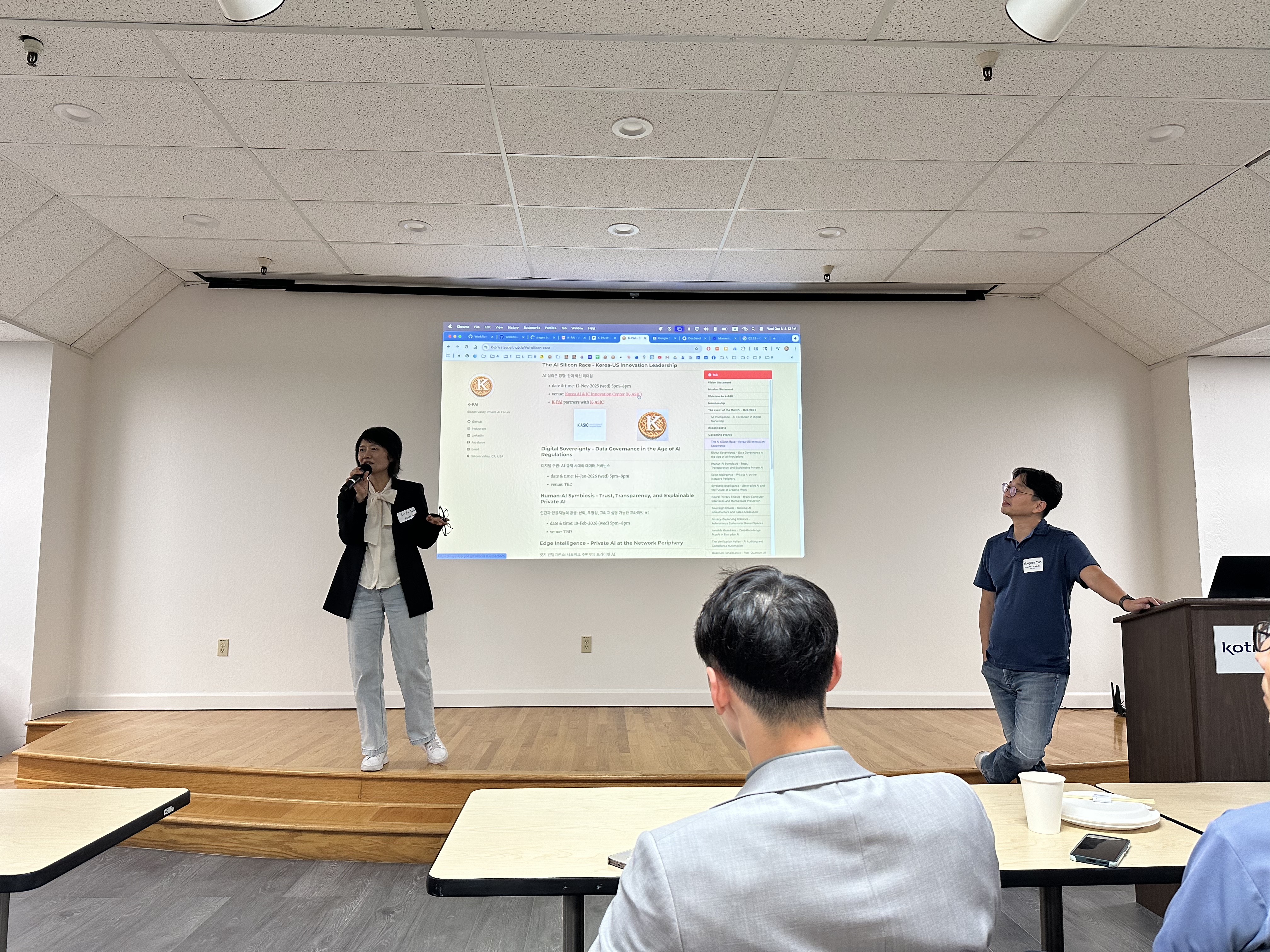
Most fundamentally, the forum reinforced that AI advertising isn’t about replacing human judgment but augmenting it—enabling marketers to make better decisions by providing data-driven insights, automating repetitive optimization tasks, and revealing patterns invisible to human analysis alone. The most successful advertising organizations will combine AI’s computational advantages with human creativity, strategic thinking, and domain expertise rather than viewing these capabilities as mutually exclusive alternatives.
The energy that pervaded the networking session—attendees clustered in animated discussions well past the scheduled conclusion—reflected genuine enthusiasm about both the specific insights shared and the broader implications for their work. Marketing professionals gained understanding of the AI systems increasingly mediating their advertising investments. Engineers discovered new problem domains where their ML expertise could create business value. Entrepreneurs identified opportunities for specialized solutions within the expansive advertising ecosystem.
The perpetual KOTRA Silicon Valley partnership’s second forum delivered on its promise - exceptional content, world-class hospitality, and meaningful professional connections that will continue generating value long after the evening concluded. The premium luxury dinner that opened the event established a tone of quality and care that carried through the technical presentations and networking session, demonstrating that institutional partnerships can enhance both operational efficiency and attendee experience.
As K-PAI moves toward its 13th forum in November on AI semiconductor innovation, the foundation established by this marketing-focused discussion will inform explorations of the computational infrastructure enabling sophisticated advertising AI. The community is building cumulative knowledge of how AI transforms industries from multiple perspectives—applications, architecture, algorithms, and hardware—creating holistic understanding rather than siloed technical depth.
The 12th K-PAI Forum proved that innovation thrives at the intersection of disciplinary boundaries, geographical connections, and institutional collaboration. By bringing together academic research (Park’s KAIST affiliation), entrepreneurial execution (Impact AI and ADOASIS), engineering excellence (Ko’s Toss USA experience), and international partnership (KOTRA Silicon Valley & K-PAI), the evening embodied the cross-pollination that drives progress in AI and its applications across industries.
The future of advertising lies not in choosing between creativity and technology, between human judgment and algorithmic optimization, but in architecting systems where each enhances the other—creating intelligent platforms that amplify human capabilities while respecting individual privacy and dignity.